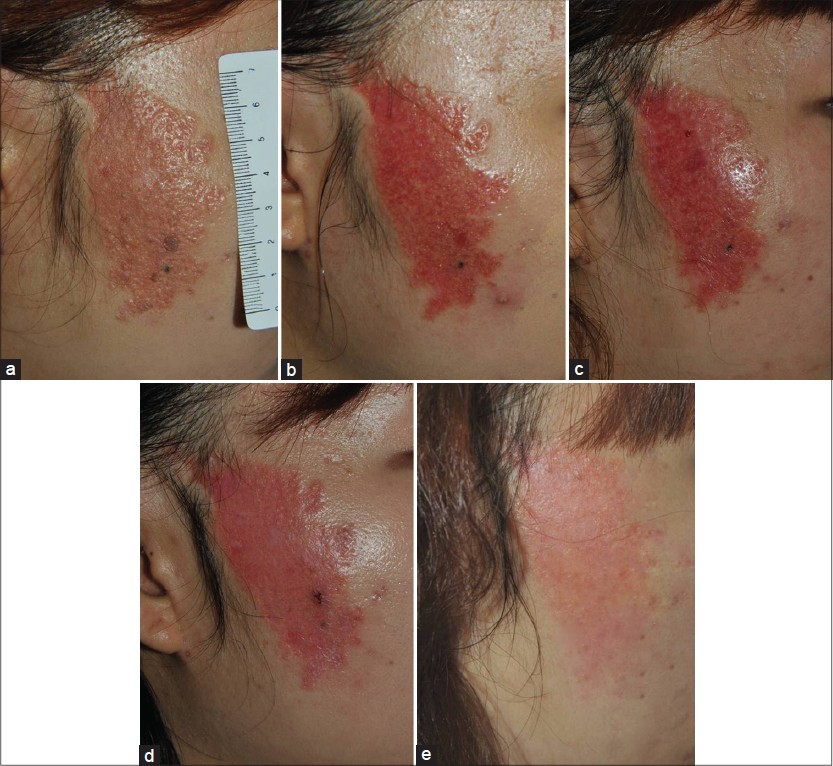Translate this page into:
Nevus sebaceous treated with fractional carbon dioxide laser followed by pulsed dye laser
Correspondence Address:
Myung Im
Department of Dermatology, Chungnam National University Hospital, 55 Munhwa-Ro, Jung-Ku, Daejon 301 - 747
Korea
| How to cite this article: Lee HE, Park SB, Lee JH, Im M. Nevus sebaceous treated with fractional carbon dioxide laser followed by pulsed dye laser. Indian J Dermatol Venereol Leprol 2014;80:478-480 |
Sir,
Nevus sebaceous is a benign neoplasm usually located on the scalp, often near the vertex, or on the face. Generally a solitary, tan or orange-yellow smooth plaque at birth, it becomes verrucous at puberty. Surgical excision is the standard treatment because the nevus extends deep into the dermis and may undergo malignant change. [1] However, excision of a large nevus sebaceous needs a subsequent graft or flap and the result may not be cosmetically acceptable, especially on the face. Laser treatment of nevus sebaceous may be a better option. Treatment with lasers such as carbon dioxide (CO 2 ), argon and erbium yttrium-aluminium-garnet (Er: YAG) laser have been reported, [2],[3],[4] but we did not find any previous reports of ablation using a fractional CO 2 laser. We report a case of nevus sebaceous on the face treated with a fractional CO 2 laser followed by a 595 nm pulsed dye laser (PDL). The results were cosmetically acceptable and there was no recurrence.
A 24-year-old woman presented to us with an 8 × 4 cm sized, tan-orange colored verrucous plaque on her face [Figure - 1]a. A skin biopsy showed epidermal hyperplasia with an increase in mature sebaceous glands. Based on clinical and pathologic findings, a diagnosis of nevus sebaceous was made. Since the nevus was large and on the face, surgical excision would have been difficult and may have caused disfigurement. We therefore decided to treat the lesion with lasers in a two-step process. First, fractional CO 2 laser ablation (Mosaic eCO 2 laser, Lutronic Corporation, Goyang, Korea) was carried out thrice at 4-week intervals. At each session, the first pass was performed with a pulse energy of 120 mJ and a density of 150 spots/cm 2 while the subsequent two passes used a pulse energy of 160 mJ in dynamic mode. The lesion became flat and reddish after ablation [Figure - 1]b-d. Next, the ablated area was treated with a 595 nm PDL (V-beam Perfecta, Candela, Boston, USA) for scar prevention. A 7 mm spot was used with a fluence of 9-11 J/cm 2 and a pulse duration of 10 ms. A dynamic cooling device delivered a 30 ms spurt and 30 ms delay prior to each laser pulse. Improvements in color and texture were seen after three sessions with the PDL at 3-week intervals [Figure - 1]e, and there was no relapse on follow-up one year after completion of treatment.
 |
| Figure 1: (a) Tan orange colored, orange peel-like plaque with well-defined margins on cheek. (b) After one session and (c) after two sessions of fractional carbon dioxide laser. (d) Flat surface and reddish color after three sessions. (e) Significant improvement in color and texture at 1 month after the last treatment with pulsed dye laser |
We decided to use the fractional CO 2 laser for nevus ablation rather than an Er: YAG laser because with the latter it is difficult to cause deep-layer destruction and to control bleeding. Fractional CO 2 laser is also a less time-consuming procedure than the conventional CO 2 laser. Though fractional CO 2 laser in dynamic mode results in a flatter surface than in the static mode, scarring can still occur. There have been reports that PDL treatment may help prevent scar formation. [5] We therefore used this modality as a second step to reduce scar formation and telangiectasia, with cosmetically acceptable results.
Fractional CO 2 laser is an easy and effective technique to ablate large lesions and subsequent treatment with PDL may help reduce scarring. We suggest this combined laser therapy as an alternative in the treatment of nevus sebaceous, although further studies are needed to confirm our findings.
| 1. |
Moody MN, Landau JM, Goldberg LH. Nevus sebaceous revisited. Pediatr Dermatol 2012;29:15-23.
[Google Scholar]
|
| 2. |
Aithal V. Nevus sebaceous: Response to erbium YAG laser ablation. Indian J Plast Surg 2005;38:48-50.
[Google Scholar]
|
| 3. |
Ashinoff R. Linear nevus sebaceus of Jadassohn treated with the carbon dioxide laser. Pediatr Dermatol 1993;10:189-91.
[Google Scholar]
|
| 4. |
Ginsbach G. Nevus sebaceous: Treatment with argon laser. Hautarzt 1980;31:338-9.
[Google Scholar]
|
| 5. |
Chan HH, Wong DS, Ho WS, Lam LK, Wei W. The use of pulsed dye laser for the prevention and treatment of hypertrophic scars in Chinese persons. Dermatol Surg 2004;30:987-94.
[Google Scholar]
|
Fulltext Views
6,577
PDF downloads
1,617





